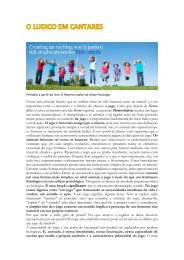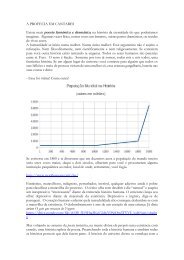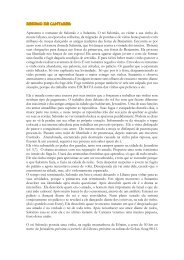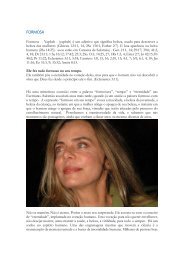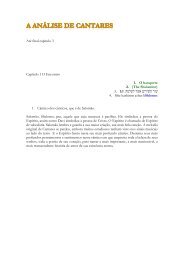Motherhood in Childhood
Create successful ePaper yourself
Turn your PDF publications into a flip-book with our unique Google optimized e-Paper software.
Monitor<strong>in</strong>g ICPD Goals – Selected Indicators<br />
Indicators of Mortality Indicators of Education Reproductive Health Indicators<br />
Chaaban, J. and W. Cunn<strong>in</strong>gham. Infant 2011. Life expectancy Duflo, Maternal E. et al. Primary 2006. enrolment Education Proportion and HIV/ Secondary Gupta, % Illiterate S., S. Mukherjee, Births per S. S<strong>in</strong>gh, Contraceptive R. Pande HIV<br />
Measur<strong>in</strong>g the Economic Ga<strong>in</strong> mortality of Invest<strong>in</strong>g M/F <strong>in</strong> AIDS mortality Prevention: (gross) Evidence M/F from reach<strong>in</strong>g a Randomized<br />
grade 5 enrolment and S. (>15 Basu. years) 2008. 1,000 “Knot Ready: Prevalence Lessons from prevalence<br />
Girls: The Girl Effect Dividend. Total Wash<strong>in</strong>gton per DC: Evaluation ratio <strong>in</strong> Western Kenya. Background M/F Paper (gross) M/FIndia M/F on Delay<strong>in</strong>g Marriage women<br />
rate (%)<br />
1,000 live<br />
aged<br />
Any for Girls.” Modern Available<br />
(15-49)<br />
World Bank.<br />
births<br />
to the 2007 World Development Report. World from: http://www.icrw.org/files/publications/<br />
15-19<br />
method methods<br />
M/F<br />
Bank Policy Research Work<strong>in</strong>g Paper 4024. Knot-Ready-Lessons-from-India-on-Delay<strong>in</strong>g-<br />
Wash<strong>in</strong>gton, DC: World Bank.<br />
Marriage-for-Girls.pdf.<br />
Chandra-Mouli, V. et al. 2013. “WHO<br />
Guidel<strong>in</strong>es on Prevent<strong>in</strong>g Early Pregnancy<br />
and Poor Reproductive Outcomes Among<br />
Adolescents <strong>in</strong> Develop<strong>in</strong>g Countries”<br />
(Commentary). Journal of Adolescent Health.<br />
52 (2013) 517.<br />
Chong, E. et al. 2006. Invest<strong>in</strong>g When it Counts:<br />
Generat<strong>in</strong>g the Evidence Base for Policies and<br />
Programmes for Very Young Adolescents. New<br />
York: UNFPA and Population Council.<br />
Colomb<strong>in</strong>i, M. 2011. Sexual and Reproductive<br />
Health Needs and Access to Services for<br />
Vulnerable Groups <strong>in</strong> Eastern Europe and Central<br />
Asia. London: London School of Hygiene and<br />
Tropical Medic<strong>in</strong>e and UNFPA.<br />
Cook, R. J. 1994. Women’s Health and Human<br />
Rights: The Promotion and Protection of Women’s<br />
Health through International Human Rights<br />
Law. Geneva: WHO. http://whqlibdoc.who.<br />
<strong>in</strong>t/publications/1994/9241561661_eng.pdf<br />
[accessed 15 July 2013].<br />
Cook R. J., J. N. Erdman, B. M. Dickens. 2007.<br />
“Respect<strong>in</strong>g adolescents’ confidentiality and<br />
reproductive and sexual choices.” International<br />
Journal of Gynecology and Obstetrics. 92: 182–87.<br />
Cott<strong>in</strong>gham, J., E. Kismodi et al. 2010. “Us<strong>in</strong>g<br />
human rights for sexual and reproductive<br />
health: improv<strong>in</strong>g legal and regulatory<br />
frameworks.” Bullet<strong>in</strong> of the World Health<br />
Organization 88: 551-555.<br />
Cowan, F. et al. 2010. “The Regai Dzive Shiri<br />
Project: Results of a Randomized Trial of an HIV<br />
Prevention Intervention for Zimbabwean Youth.”<br />
AIDS. 24(16): 2541–2552.<br />
Cunn<strong>in</strong>gham, W. et al. 2008. Youth at risk <strong>in</strong><br />
Lat<strong>in</strong> America and the Caribbean. Understand<strong>in</strong>g<br />
the causes, realiz<strong>in</strong>g the potential. Wash<strong>in</strong>gton<br />
DC: World Bank.<br />
Dehne, K. and G. Riedner. 2005. Sexually<br />
Transmitted Infections Among Adolescents: The<br />
Need for Adequate Health Services. Geneva:<br />
World Health Organization and Deutsche<br />
Gesellschaft fuer Technische Zusammenarbeit<br />
(GTZ).<br />
de Silva-de-Alvis, R. 2008. Child Marriage and<br />
the Law. Legislative Reform Initiative Paper<br />
Series (Work<strong>in</strong>g Paper). New York: UNICEF.<br />
http://www.unicef.org/policyanalysis/files/<br />
Child_Marriage_and_the_Law(1).pdf, [accessed<br />
15 July 2013].<br />
Dixon-Mueller, R. 2008. “How Young Is<br />
‘Too Young’? Comparative Perspectives on<br />
Adolescent Sexual, Marital, and Reproductive<br />
Transitions.” Studies <strong>in</strong> Family Plann<strong>in</strong>g. 39 (4):<br />
December 2008.<br />
112 112 INDICATORSBIBLIOGRAPHY<br />
Duflo E., P. Dupas, and M. Kremer. 2011.<br />
“Education, HIV and Early Fertility: Experimental<br />
Evidence from Kenya.” Cambridge: Poverty<br />
Action Lab. http://www.povertyactionlab.org/<br />
publication/education-hiv-and-early-fertilityexperimental-evidence-kenya.<br />
Dupas, P. 2011. "Do Teenagers Respond to<br />
HIV Risk Information? Evidence from a Field<br />
Experiment <strong>in</strong> Kenya.” American Economic Journal:<br />
Applied Economics 3 (January 2011): 1–34 http://<br />
www.aeaweb.org/articles.php?doi=10.1257/<br />
app.3.1.1.<br />
Ed<strong>in</strong>, K. and M. Kefalas. 2012. Promises I Can<br />
Keep: Why Poor Women Put <strong>Motherhood</strong> before<br />
Marriage. Berkeley: University of California<br />
Press.<br />
Erulkar, A. and E. Muthengi. 2009. “Evaluation<br />
of Berhane Hewan: A Program to Delay Child<br />
Marriage <strong>in</strong> Rural Ethiopia.” International<br />
Perspectives on Sexual and Reproductive Health.<br />
35(1): 6-14.<br />
Erulkar, A. S. 2004. “The Experience of Sexual<br />
Coercion Among Young People <strong>in</strong> Kenya.”<br />
International Family Plann<strong>in</strong>g Perspectives. 30(4):<br />
182-189.<br />
Erulkar, A. 2013. “Early Marriage, Marital<br />
Relations and Intimate Partner Violence <strong>in</strong><br />
Ethiopia.” International Perspectives on Sexual<br />
and Reproductive Health. 39 (1): March 2013.<br />
Filmer, D., J. Friedman and N. Shady. 2008.<br />
“Development, Modernization, and Son<br />
Preference <strong>in</strong> Fertility Decisions.” Development<br />
Research Group. Wash<strong>in</strong>gton, DC: The<br />
World Bank.<br />
Garcia-Moreno, C., H. AFM Jansen, M. Ellsberg<br />
et al. 2005. WHO Multi-country Study on<br />
Women’s Health and Domestic Violence aga<strong>in</strong>st<br />
Women: Initial results on prevalence, health<br />
outcomes and women’s responses. Geneva: World<br />
Health Organization.<br />
Girls Not Brides. 2011. “A message to men<br />
and boys from Archbishop Desmond Tutu.”<br />
http://www.girlsnotbrides.org/desmond-tutua-message-to-men-and-boys-about-childmarriage/<br />
[accessed 1 July 2013].<br />
Goicolea, I. 2009. “Adolescent Pregnancies<br />
<strong>in</strong> the Amazon Bas<strong>in</strong> of Ecuador: A Rights<br />
and Gender Approach to Girls’ Sexual and<br />
Reproductive Health.” Dissertation, Umea<br />
University.<br />
Grant, M. and K. Hallman. 2006. “Pregnancyrelated<br />
School Dropout and Prior School<br />
Performance <strong>in</strong> South Africa,” Policy Research<br />
Division, Population Council, 2006, No. 212.<br />
Gurman, T. A. and C. Underwood. 2008.<br />
“Us<strong>in</strong>g Media to Address Adolescent Sexual<br />
Health: Lessons Learned Abroad” <strong>in</strong> Manag<strong>in</strong>g<br />
the Media Monster. The Influence of Media (from<br />
Television to text messages) on Teen Sexual<br />
Behavior and Attitude. Edited by J. D. Brown.<br />
Wash<strong>in</strong>gton DC: National Campaign to Prevent<br />
Teen and Unplanned Pregnancy.<br />
The Guttmacher Institute and International<br />
Planned Parenthood Federation. 2013.<br />
Demystify<strong>in</strong>g Data: A guide to us<strong>in</strong>g evidence to<br />
improve young peoples’ sexual health and rights.<br />
New York: Guttmacher Institute and IPPF.<br />
The Guttmacher Institute and the International<br />
Planned Parenthood Federation. 2010. In Brief:<br />
Facts on the Sexual and Reproductive Health of<br />
Adolescent Women <strong>in</strong> the Develop<strong>in</strong>g World. New<br />
York: Guttmacher Institute and IPPF.<br />
The Guttmacher Institute. 2010. “Facts on<br />
Un<strong>in</strong>tended Pregnancy and Abortion <strong>in</strong><br />
Ethiopia.” New York: Guttmacher Institute.<br />
Haberland, N. and D. Rogow. 2013.<br />
“Comprehensive Sexuality Education.”<br />
Background paper for expert group meet<strong>in</strong>g on<br />
adolescent sexual and reproductive health, 4–6<br />
February 2013. Manhasset, New York.<br />
Ha<strong>in</strong>sworth, G. et al. 2009. From Inception to<br />
Large Scale: The Geração Biz Programme. Geneva:<br />
World Health Organization and Pathf<strong>in</strong>der<br />
International.<br />
Hallman, K. and E. Roca. 2011. “Siyakha<br />
Nentsha: Build<strong>in</strong>g economic, health and<br />
social capabilities among highly vulnerable<br />
adolescents <strong>in</strong> KwaZulu-Natal, South Africa.”<br />
Provid<strong>in</strong>g Healthy, Safe, and Productive Transitions<br />
to Adulthood. Brief No. 4. New York: Population<br />
Council.<br />
Heise, L., K. Moore and N. Toubia. 1995. Sexual<br />
coercion and reproductive health: A focus on<br />
research. New York: Population Council.<br />
Heise, L. 2011. What Works to Prevent Partner<br />
Violence? An Evidence Overview. World Paper<br />
(Version 2.0). London: Department for<br />
International Development.<br />
Hilton, P. and A. Ward. 1998. Epidemiological<br />
and surgical aspects of urogenital fistulae: a<br />
review of 25 years’ experience <strong>in</strong> southeast<br />
Nigeria. International Urogynecology Journal<br />
and Pelvic Floor Dysfunction. 9(4): 189-94.








